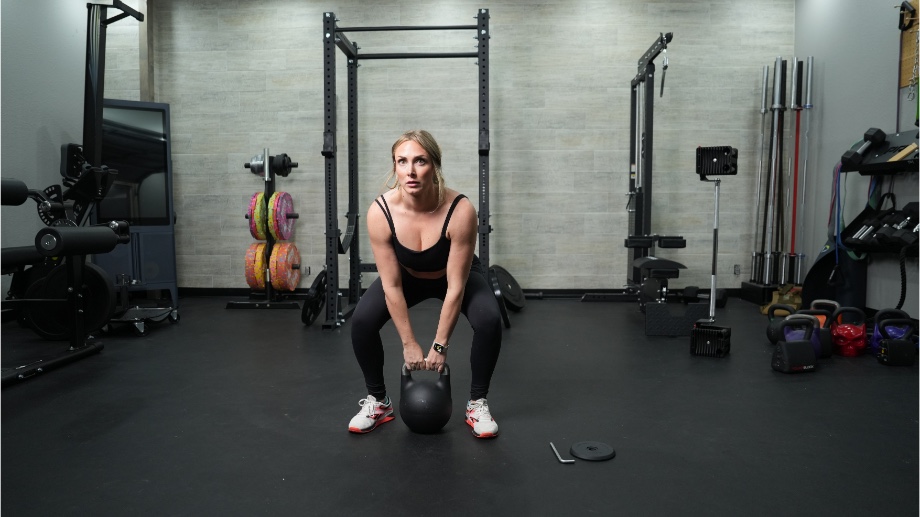We test and review fitness products based on an independent, multi-point methodology. If you use our links to purchase something, we may earn a commission. Read our disclosures.
You can do more than a handful of exercises with a pair of the best kettlebells (e.g., the kettlebell swing, farmer’s carry, and goblet squat), but did you know you can use them for your deadlifts, too?
That’s right!—the kettlebell deadlift trades the barbell on this weightlifting classic for a single kettlebell, offering versatility, stability, and mobility. It’s beginner-friendly and super functional since it more closely mimics how you pick up heavy objects in your everyday life.
RELATED: What Is Functional Fitness?
We asked Caine Wilkes, OLY, USAW-1, and GGR senior staff writer, to share everything you’ll need to know to do kettlebell deadlifts with proper form so you can incorporate this versatile deadlift variation into your strength training today! Let’s get lifting, fit fam!
How To Do the Kettlebell Deadlift
The KB deadlift may feel familiar if your barbell deadlift form is down pat. For example, the starting position involves maintaining a neutral spine, tall chest, tight core, and eyes tracking forward. That said, there are a few key differences outlined below.
How to do it:
- Stand with your feet hip-width apart and a kettlebell on the floor in front of you.
- Hinge forward by pushing your hips back, lowering your chest, and bending your knees.
- Grip the kettlebell handle with a double overhand grip.
- Brace your core, inhale, and exhale as you drive through your feet and extend your knees and hips. Continue until you reach a standing position.
- Squeeze your glutes at the top, then reverse the movement and return the kettlebell to the floor.
- Repeat for reps.
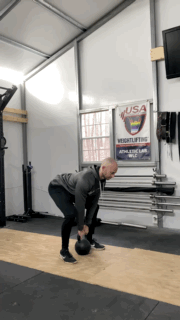
Modifications
- Dial it back: Use a light kettlebell or practice your hip hinge by doing the good morning exercise.
- Make it harder: Use a heavier kettlebell or perform a single-leg kettlebell deadlift variation.
How To Do the Kettlebell Deadlift At Home
Performing a kettlebell deadlift at home is as easy as grabbing a jug of water, laundry detergent, or another similarly-shaped object and repeating the steps above.
Kettlebell Deadlift Variations
- Suitcase Kettlebell Deadlift: Instead of holding the kettlebell in front of your body with an overhand grip, hold the kettlebell on either side using a neutral grip.
- Sumo Kettlebell Deadlift: Take the movement pattern of the regular kettlebell deadlift and widen the stance beyond hip- or shoulder-width for more stability and mobility.
- Kettlebell Romanian Deadlift: The RDL reverses the movement of the regular deadlift, so you’ll start by standing and slowly hinging forward to bring the kettlebell toward the floor, targeting posterior chain muscles like your glutes, hamstrings, and lower back.
RELATED: 13 Posterior Chain Exercises
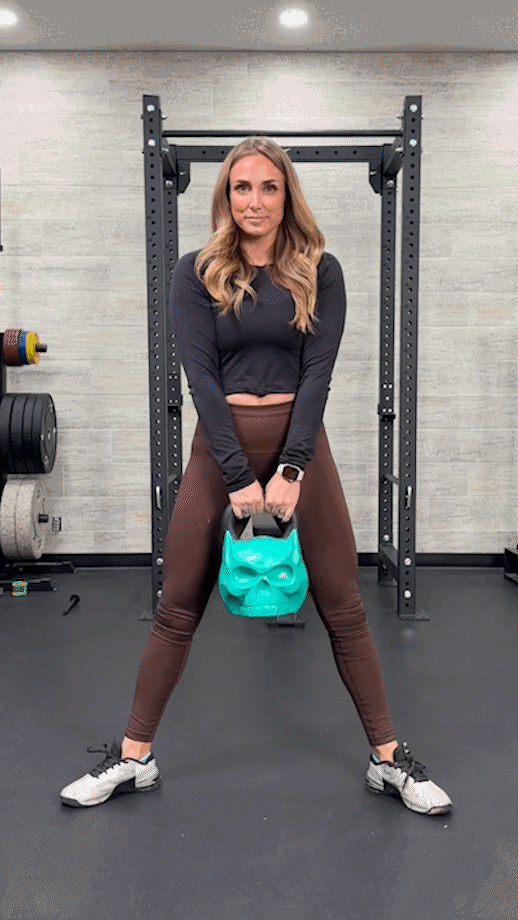
Kettlebell Deadlift Alternatives
The deadlift is considered an exercise GOAT, but that doesn’t make it the end-all-be-all. There are plenty of other kettlebell exercises to incorporate into your kettlebell training.
Here’s a rundown of some of the best kettlebell deadlift alternatives.
Suitcase Deadlift
Why do it: “The suitcase deadlift is extremely functional since it closely imitates how you’d lift an object, like a suitcase, in everyday life,” says Caine Wilkes, OLY, USAW-1. “Plus, you can do a double kettlebell suitcase deadlift, but training one side at a time builds unilateral strength.”
How to do it:
- Stand with your feet hip-width apart and a kettlebell placed directly next to one foot.
- Hinge forward by pushing your hips back, lowering your chest, and bending your knees.
- Grip the kettlebell handle with a neutral grip.
- Brace your core and drive through your feet to stand.
- Squeeze your glutes, then reverse the movement and return the kettlebell to the floor.
- Repeat for reps, then switch sides and repeat the set.
RELATED: Unilateral Exercises
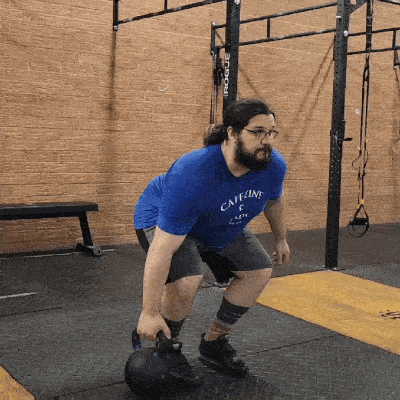
Kettlebell Romanian Deadlift
Why do it: According to PLoS One1, the RDL produces less activation on the lower back while emphasizing hamstring muscles like the biceps femoris and semitendinosus. Kettlebells work great for the standard RDL, but they really shine if you’re doing single-leg Romanian deadlifts.
How to do it:
- Stand with your feet hip-width apart and a kettlebell held in front of you with both hands.
- Push your hips back and lower your chest, keeping your legs straight.
- Continue until you feel a strong stretch in your hamstrings.
- Pause, then drive through your heels to return to the starting position.
- Repeat for reps.
RELATED: Romanian Deadlift Vs Deadlift
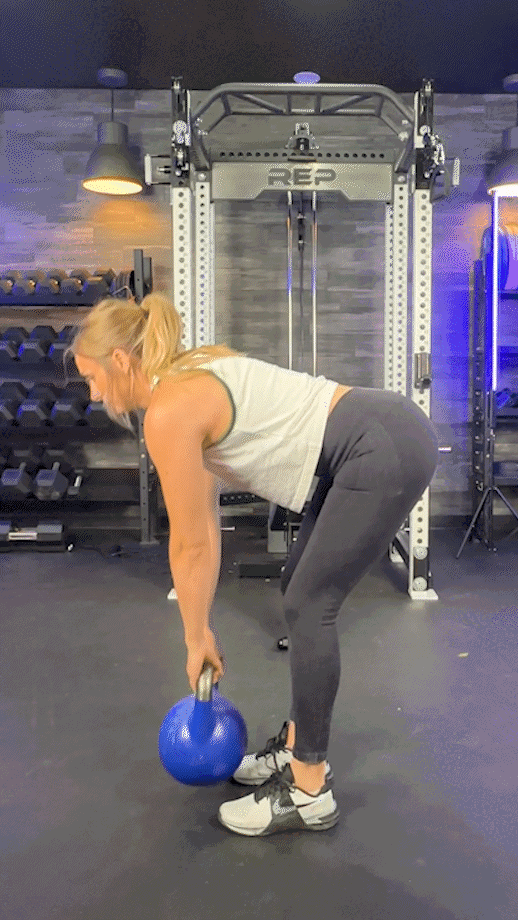
Landmine Romanian Deadlift
Why do it: “Doing Romanian deadlifts with the landmine attachment is beneficial for lifters who are struggling to maintain a neutral spine position due to the difference in how you grip the bar,” says Caine. “Landmine RDLs also help build grip strength and balance.”
How to do it:
- Set up your station, load your barbell, and stand facing your landmine base.
- Squat down to grip the bar at the end of the sleeve, cupping your hands beneath it.
- Return to a standing position, holding the bar in front of the pelvis region.
- Brace your core, push your hips back, bring your chest forward, and slowly lower the bar towards the floor, bending your knees slightly as you move.
- Continue until you feel a stretch in your hamstrings.
- Pause, then drive through your feet and return to a standing position.
- Squeeze your glutes, then cycle into the next rep.
- Repeat as needed.
RELATED: Best Landmine Exercises
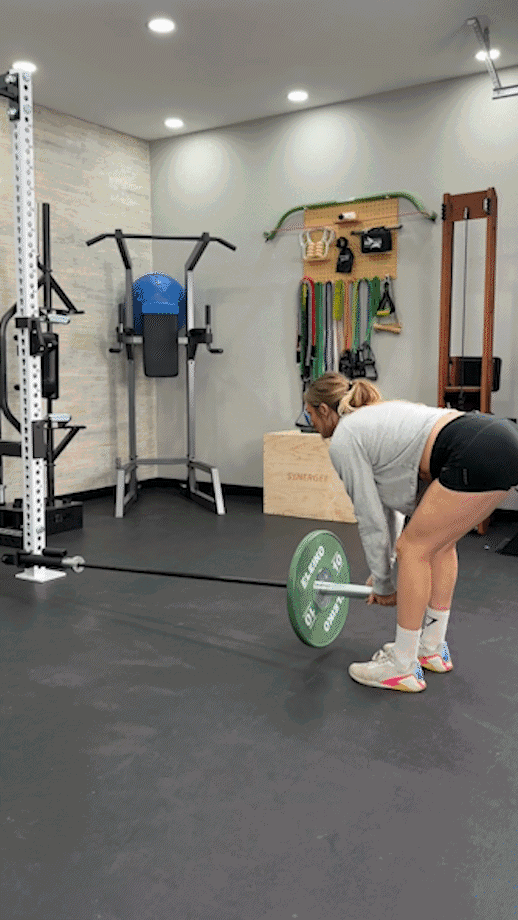
Cable Rope Pull-Through
Why do it: The cable rope pull-through—like the kettlebell deadlift—is a hip hinge exercise that targets lower body muscle groups and the posterior chain. However, it provides a distinctly different stimulus due to the constant tension provided by the cable machine.
How to do it:
- Set your cable machine pulley to the lowest setting and add the rope attachment.
- Stand facing away from the machine, hinge forward, and grip the rope through your legs.
- Step forward to create tension on the cable.
- Extend your hips and hinge back to a standing position.
- Squeeze your glutes, then slowly hinge forward again.
- Repeat for reps.
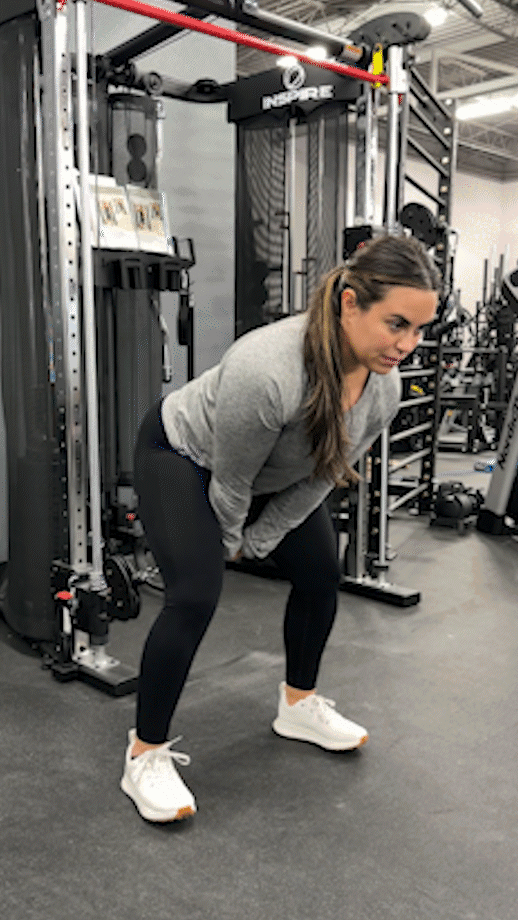
Sumo Deadlift
Why do it: The sumo deadlift allows you to create a more stable base by widening your stance. That means it’s friendlier on your lower back, lets you move heavier weights, and, according to the Journal of Sports Science & Medicine2, may be “mechanically advantageous” for tall lifters or individuals with longer torsos.
How to do it:
- Stand with your feet wider than hip-width apart and a loaded barbell on the floor.
- Hinge forward by pushing your hips back, lowering your chest, and bending your knees.
- Grip the bar with a double overhand or mixed grip.
- Brace your core, inhale, and then exhale as you drive through your feet and extend your knees and hips. Continue until you reach a standing position.
- Squeeze your glutes, then reverse the movement and return the weight to the floor.
- Repeat for reps.
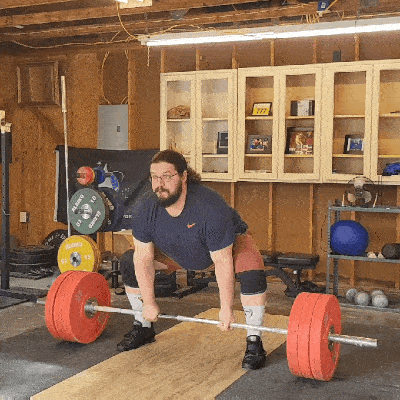
Kettlebell Swing
Why do it: The kettlebell swing is the cornerstone of most kettlebell workouts because they’re stupidly effective. They’re a full-body exercise, help strengthen the hip hinge movement, and, according to a 2023 study3 in PLoS One, may greatly improve cardiorespiratory fitness, too.
How to do it:
- Stand with your feet hip-width apart and both hands holding your kettlebell by the horns.
- Push your hips back, bring your chest down, and bend your knees to hinge forward.
- Forcefully extend your knees and heels to propel the kettlebell into the air.
- Swing the kettlebell to chest height. Squeeze your glutes at the top.
- Hinge forward again as the kettlebell swings between your legs and behind you.
- Cycle into the next rep as the kettlebell swings forward again.
- Repeat for reps.
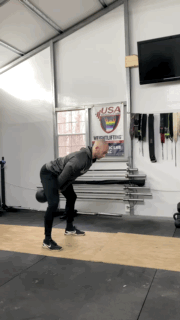
Benefits of the Kettlebell Deadlift
You won’t max out your deadlift using a kettlebell, but that doesn’t mean you can’t achieve benefits that make it well worth your effort.
Helps Strengthen Your Hip Hinge Movement
The barbell deadlift remains a tried-and-true training method to build muscle and full-body strength, but it’s not necessarily the most approachable exercise for developing hip hinge movement. Yet, much of your weightlifting success relies on a solid hip hinge.
“The kettlebell deadlift is a highly accessible and effective way to practice and strengthen the hip hinge movement,” says Caine Wilkes, OLY, USAW-1. “It tends to be easier for beginners to grasp and translates directly to improved deadlift performance when you start moving heavy weights later on.”
May Provide More Unilateral Training Potential
Intermediate and advanced lifters may find unilateral training with a barbell to be no issue. For the rest of us, it’s daunting and downright difficult to deadlift a barbell while balancing on one leg.
On the other hand, The kettlebell deadlift allows you to easily switch from a double overhand grip to a neutral grip by simply switching over to the suitcase deadlift. The kettlebell single-leg deadlift is also significantly more approachable than the same exercise using a barbell simply because of the differences in the weight distribution.
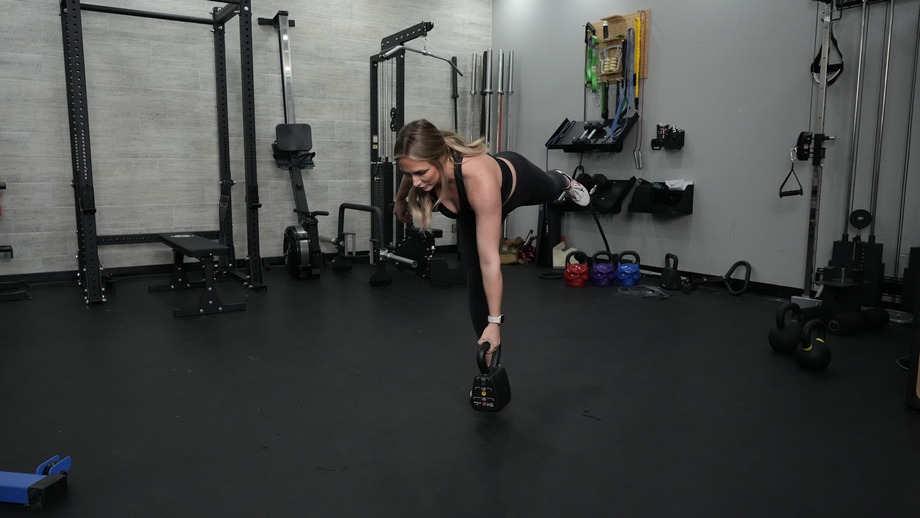
So, if correcting muscle imbalances and bilateral deficits is on your goal tracker, kettlebell deadlifts and deadlift variations using kettlebells will likely be of greater use.
May Help Alleviate Low Back Pain
Low back pain affects a vast portion of the global population, and some researchers believe that an exercise program featuring the deadlift exercise can help alleviate symptoms.
According to the Journal of Sport Rehabilitation4, “Deadlifts can yield improvements in both pain and function for those living with low back pain,” but further research will be needed to establish the clinical efficacy of this approach.
If you suffer from chronic low back pain, consult your doctor or other healthcare professional to see whether an exercise program that involves deadlifts may be right for you.
Common Kettlebell Deadlift Mistakes
Your success performing the kettlebell deadlift hinges on proper form. That’s why it’s prudent to watch out for these common mistakes associated with the kettlebell deadlift.
Not Bracing Your Core
The kettlebell deadlift mostly activates muscles in your lower body, but you can do significant damage by neglecting your upper body, specifically your core muscles, during the lift.
“A successful lift hinges on proper upper body positioning,” says Caine. “That includes a flat back, neutral spine position, relaxed shoulders, and, of course, a braced core to protect the lumbar from shear forces.”
Shortening Your Range of Motion
Kettlebells are smaller than barbells, meaning you’ll have to stretch farther to scoop them up from the floor and deadlift them. That may be challenging if you suffer from general stiffness or mobility issues in the hips or thoracic spine.
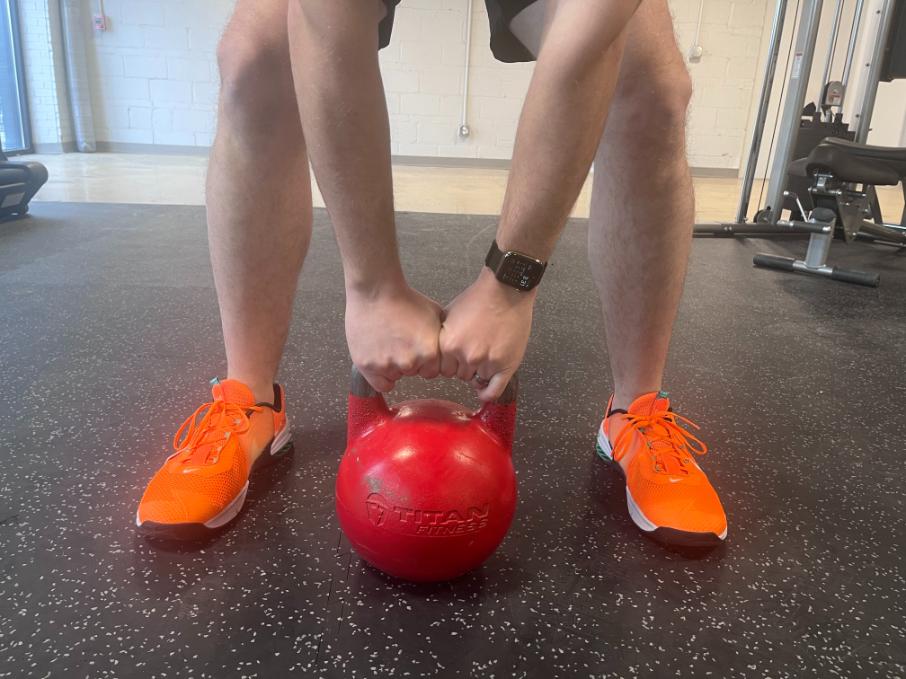
To combat this, work some mobility exercises into your warm-up to help yourself feel loose and limber by the time you reach down for your first rep. This will help ensure you get the full range of motion and reduce your risk of injury. Win-win.
Shifting Your Weight Onto Your Toes
As with all deadlift variations, the idea is to keep a strong and stable base by shifting your weight into your heels and driving through them to initiate the eccentric phase of the exercise.
You’ll have a hard time producing that kind of power if you shift your weight forward onto the balls of your feet or your toes. Worse yet, you could lose your balance, stumble, tumble, and fall.
“If you’re regularly shifting your weight forward onto your toes, it may stem from mobility issues,” says Caine, “but, most often, it’s a sign you’ve picked a weight that’s too heavy for you to move with proper form.”
Try using a lighter kettlebell, and if you’re still feeling off balance, consider working with a certified personal trainer or other qualified fitness professional to diagnose and correct the underlying issue.
RELATED: Best Online Personal Trainer
Muscles Worked by the Kettlebell Deadlift
Kettlebell deadlifts (and most deadlift variations) are ideal for muscle hypertrophy because they provide activation virtually everywhere.
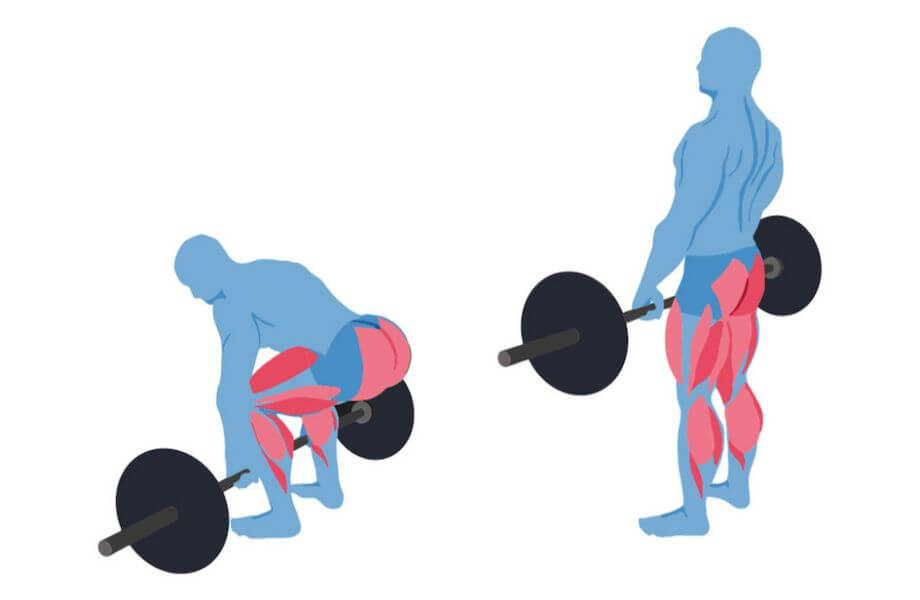
The most crucial muscle groups used during the kettlebell deadlift include:
- Quadriceps: The quads control knee flexion, so you’ll need them working hard to push through the eccentric phase of the exercise and reach a standing position.
- Hamstrings: The hammies form an antagonistic pair with the quadriceps, assisting in knee flexion and hip extension. These muscles work hard during the regular deadlift but are even more crucial during the RDL variation.
- Glutes: The glute muscles help flex and extend your hips. Since the kettlebell deadlift is fundamentally a hip hinge movement, your glutes serve as primary movers.
- Upper body: A strong, rigid posture protects your trunk and keeps it moving efficiently. Properly bracing your core and back muscles, including the traps, lats, and erector spinae, helps achieve this.
RELATED: Deadlift: Muscles Worked
Kettlebell Deadlift: Final Thoughts
The deadlift exercise is a functional and effective way of achieving many personal fitness goals. Using a kettlebell, however, does offer some advantages you can’t get from the barbell version.
Kettlebells offer a wider range of motion for increased mobility, stability, and versatility, are fantastic for practicing the all-important hip hinge movement mechanic, and serve as a top-tier alternative to the classic barbell lift, translating to improved barbell deadlift performance.
So, don’t count out this incredible and underrated deadlift variation. Give the kettlebell deadlift a try during your next strength training session!
Kettlebell Deadlift: FAQs
Is it better to deadlift with a kettlebell or barbell?
The best deadlift variation for your purposes depends on your personal fitness goals.
For lifters looking for unparalleled strength gains, maxing out on a classic barbell deadlift is one of the best and most widely used avenues for achieving that goal.
The kettlebell deadlift is beginner-friendly, offers increased mobility, stability, and versatility, a higher potential for unilateral applications, and an accessible way to enhance your hip hinge mechanics.
What is a good weight for kettlebell deadlift?
“A good weight for the kettlebell deadlift is a weight you can move with proper form throughout your sets,” says Caine Wilkes, OLY, USAW-1, and GGR senior staff writer. “So, if you have a set of 8 to 12 reps in your workout, you should select a weight that’s difficult to lift on the last two or three reps. Struggling on the first rep means that you’ve gone too heavy!”
How many reps for kettlebell deadlift?
Your personal fitness goals come into play big-time when selecting the ideal rep range and loading pattern. It’s best to consult a personal trainer for a personalized plan, but, generally speaking, the following rep schemes tend to be effective for most lifters:
–For strength: Choose a heavy kettlebell and complete 1 to 5 reps per set
–For hypertrophy: Use a moderate kettlebell and do 8 to 12 reps per set
–For endurance: Use a light kettlebell and perform 15 to 20 reps per set
RELATED: How Many Reps To Build Muscle
Do kettlebells make you stronger than weights?
It almost doesn’t matter whether you’re using a barbell, dumbbells, kettlebells, or some other form of resistance; as long as you’re lifting heavy, practicing proper form, giving yourself enough recovery time, and eating right outside the gym, you should see results from your work in the form of strength gains.
That said, barbells allow for maximum loading, making them slightly more intuitive than kettlebells when your goal is building strength.
References
1. Martín-Fuentes I, Oliva-Lozano JM, Muyor JM. Electromyographic activity in deadlift exercise and its variants. A systematic review. PLoS One. 2020;15(2):e0229507. Published 2020 Feb 27. doi:10.1371/journal.pone.0229507
2. Cholewa JM, Atalag O, Zinchenko A, Johnson K, Henselmans M. Anthropometrical Determinants of Deadlift Variant Performance. J Sports Sci Med. 2019;18(3):448-453. Published 2019 Aug 1.
3. Melo X, Arrais I, Marôco JL, et al. Effects of kettlebell swing training on cardiorespiratory and metabolic demand to a simulated competition in young female artistic gymnasts. PLoS One. 2023;18(4):e0283228. Published 2023 Apr 24. doi:10.1371/journal.pone.0283228
4. Fischer SC, Calley DQ, Hollman JH. Effect of an Exercise Program That Includes Deadlifts on Low Back Pain. J Sport Rehabil. 2021;30(4):672-675. Published 2021 Feb 24. doi:10.1123/jsr.2020-0324
Further reading

No matter how you toss or drop them, these slam balls can endure some wear and tear. Here are our picks for the best slam balls on the market. Read more

If you need more reasons to add a protein supplement to your diet, a certified personal trainer is here to give you the top benefits of protein powder. Read more

Find the perfect gift for your team with our guide to wellness gifts for employees. Read more

Finding the best commercial treadmill on your own can be tough, which is why Garage Gym Reviews is here to save the day! Check out our five favorite options. Read more

